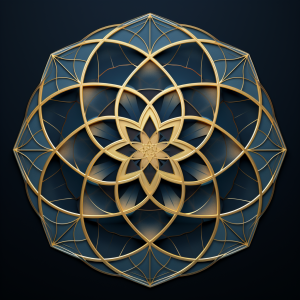In a world of intricate patterns and harmonious forms, one ancient concept reigns supreme: Holy Geometry. Derived from the Greek word “geo” meaning earth and “metron” meaning measure, Holy Geometry provides a lens through which we can unlock the power and beauty within the universe.
From sacred structures to artistic masterpieces, this mystical realm has captured the imaginations of scholars, artists, and spiritual seekers throughout history. In this article, we embark on a journey into the enchanting world of Holy Geometry, exploring its definition, significance, and its profound presence in various aspects of human existence.
Holy Geometry encompasses more than just mathematical shapes; it holds deep symbolic meaning and is woven into the fabric of ancient civilizations. Through time-honored practices and timeless wisdom passed down from generation to generation, certain cultures have embraced Holy Geometry as a means to communicate with higher realms.
By studying their rich tapestry of knowledge and exploring their archaeological marvels, we trace back to the origins of Holy Geometry in ancient civilizations such as Egypt and Mesopotamia. These remarkable civilizations left behind awe-inspiring structures encoded with sacred symbolism that continue to fascinate modern researchers.
At its core, Holy Geometry is rooted in mathematical principles that shape our understanding of the natural world. Through unraveling these principles, we not only gain insights into the interconnectedness of all things but also establish a deep connection between mathematics and spirituality. By examining famous mathematical theorems and constructions rooted in Holy Geometry, we begin to comprehend how these seemingly abstract concepts have practical applications in our daily lives.

But Holy Geometry extends beyond mere calculations; it has the power to elevate our aesthetic experiences too. From architectural wonders to mesmerizing works of art, geometric forms inspired by Holy Geometry captivate our senses and unleash an innate sense of harmony within us. We delve into how artists throughout history have harnessed these geometrical designs to create visually captivating creations that speak directly to our souls.
As we embark on this exploration, we will peel back the layers of understanding Holy Geometry and discover its profound presence in sacred spaces, holistic practices, and modern society. From the blueprint of ancient temples to sustainable design, from the therapeutic benefits to contemporary applications, Holy Geometry continues to influence and shape the world around us. Brace yourself for a transcendent existence as we delve into the depths of Holy Geometry and unlock its secrets together.
The Origins of Holy Geometry
Holy Geometry, also known as sacred geometry, has its origins in ancient civilizations that laid the foundation for this mystical realm. Tracing back to these early cultures provides insight into the profound significance and symbolism of Holy Geometry. Ancient civilizations such as Egypt and Mesopotamia left behind remarkable examples of sacred geometric structures that continue to captivate and inspire.
In Egypt, one of the most notable examples of Holy Geometry can be found in the design and construction of the pyramids. The shape of these monumental structures, with their perfectly aligned sides and angles, reflects mathematical precision and a deep understanding of geometric principles.
The dimensions of the pyramids are believed to have been derived from sacred numbers like pi and phi, which are integral to Holy Geometry. Additionally, the alignment of the Great Pyramid with celestial bodies further highlights their connection to sacred geometry.
Mesopotamia is another civilization that embraced Holy Geometry in its architectural marvels. The ziggurats, towering stepped structures built by ancient Mesopotamians, were not only places of worship but also embodied the sacred principles of geometry. The careful planning and construction techniques employed in building these ziggurats display an understanding of proportion, symmetry, and mathematical harmonies. Each step of the ziggurats was carefully designed to uphold certain mathematical ratios that adhered to divine order.
Beyond architecture, ancient civilizations utilized Holy Geometry across various realms such as art, astronomy, and religious practices. Geometric symbols were often incorporated into religious rituals as a means to connect with higher realms or deities. For instance, mandalas – intricate geometric patterns used in Hinduism and Buddhism – serve as tools for meditation and spiritual transformation.
The presence of Holy Geometry in ancient civilizations reveals its fundamental role not only in shaping physical structures but also in expressing spiritual beliefs and cosmic interconnectedness. These early cultures recognized the power woven within these geometrical patterns and saw them as pathways to divine wisdom. By understanding the origins of Holy Geometry in ancient civilizations, we can appreciate its enduring legacy and continue to unlock its hidden meanings in our own spiritual journey.
The Mathematical Magic of Holy Geometry
Understanding the mathematical principles behind Holy Geometry is essential to fully grasp the power and beauty associated with this ancient concept. Holy Geometry is not simply a collection of shapes or patterns; it is a system that encompasses the mathematical relationships and proportions found in nature, art, and architecture. Through these mathematical principles, Holy Geometry connects the physical world to the spiritual realm, revealing a hidden order and harmony underlying all existence.
Exploring Mathematical Patterns and Spiritual Concepts
One of the fundamental aspects of Holy Geometry is its ability to illustrate the interplay between mathematics and spirituality. The perfect symmetry, proportionality, and harmony found in geometric forms are believed to reflect divine principles governing the universe. From the intricate shapes of snowflakes to the spiral patterns seen in seashells, nature itself provides countless examples of mathematical patterns that evoke a sense of awe and wonder.
These connections between math and spirituality have been recognized throughout history. Ancient civilizations such as the Egyptians and Greeks revered certain geometric forms for their symbolic representation of cosmic order. Plato proposed that geometry was one of the keys to understanding reality, suggesting that there exists an eternal realm composed entirely of pure geometrical forms.
Famous Theorems Rooted in Holy Geometry
Holy Geometry has also contributed significantly to mathematical advancements over centuries. Some of the most famous mathematical constructions and theorems can be traced back to this ancient concept.
One prominent example is Pythagoras’ theorem, which states that in a right-angled triangle, the square on the hypotenuse (the side opposite the right angle) is equal to the sum of squares on other two sides. This theorem not only serves as a foundation for trigonometry but also exemplifies how mathematics can reveal profound truths about fundamental relationships within geometric shapes.
Another notable theorem derived from Holy Geometry is Euclid’s formulation of circles – their properties have since become the basis for understanding curved shapes and calculus. Euclid’s work in geometrical proofs paved the way for modern mathematical reasoning and laid the groundwork for countless scientific advancements.
As we delve further into Holy Geometry, we will uncover more hidden mathematical treasures that give rise to both practical applications and spiritual interpretations. By understanding these principles, we can develop a deeper appreciation for the enchanted world of Holy Geometry and unlock its potential to awaken our own spiritual insights.

Sacred Sites and Holy Geometry
Examining the Presence of Holy Geometry in Famous Sacred Sites
Throughout history, sacred sites have been built with great care and precision, often incorporating elements of Holy Geometry. These sites serve as physical manifestations of spiritual beliefs and are designed to enhance the connection between humans and the divine.
One famous example is the Great Pyramids of Egypt, which are not only architectural marvels but also imbued with sacred geometric principles. The pyramids’ precise alignment to cardinal directions and their relationship to celestial bodies highlight an understanding of Holy Geometry that was advanced for its time.
Another notable example is Stonehenge, an ancient stone circle in England. The arrangement of the stones at Stonehenge exhibits a deep understanding of geometric patterns and astronomical alignments. This sacred site has long mystified archaeologists and researchers due to its mathematical precision and intentional placement within the landscape.
Analyzing the Spiritual Symbolism Encoded in Geometric Structures
Sacred sites often contain geometric structures that hold symbolic meaning beyond their physical form. For instance, the mandala, a circular geometric pattern frequently found in religious art and architecture, represents wholeness and unity in many traditions. Mandalas are believed to aid individuals in finding harmony within themselves and connecting with higher states of consciousness.
Labyrinths are another type of structure that incorporates Holy Geometry into their design. As one walks through a labyrinth’s intricate pathways, they undergo a meditative journey that represents an inner journey towards self-discovery or union with the divine.
Enhancing Spiritual Experience through Geometric Configurations
The inclusion of Holy Geometry within sacred sites serves multiple purposes: it amplifies spiritual energy, creates harmony within the space, and allows individuals to immerse themselves more deeply in their spiritual practice. The precise measurements and alignments utilized in these structures create a sense of balance and symmetry that can elicit feelings of peace and serenity.
Furthermore, the geometric configurations incorporated into sacred sites can act as energetic conduits, connecting individuals to higher realms. By aligning with these geometries and meditating within these spaces, practitioners may experience a heightened sense of spiritual connection and transcendence.
The Alchemy of Aesthetics
Unleashing the Beauty of Holy Geometry
Holy Geometry, with its intricate and harmonious patterns, has long captivated artists, architects, and designers. The inherent beauty and visual appeal of this ancient concept have been utilized throughout history to create visually captivating creations. From the grandeur of Gothic cathedrals to the delicate symmetry in Islamic art, Holy Geometry has played a significant role in inspiring artistic masterpieces.
One of the remarkable aspects of Holy Geometry is its ability to create harmony and balance within artistic compositions. Through the precise arrangement of geometric shapes, artists are able to evoke a sense of order and unity. This harmonious quality can be seen in various art forms such as paintings, sculpture, and even textile design.
In architecture, Holy Geometry has been instrumental in creating awe-inspiring structures that stand the test of time. Take for example the Great Pyramid of Giza in Egypt, which showcases precise mathematical proportions based on Holy Geometry principles. By incorporating these principles into the design process, architects are able to achieve a sense of balance and proportion that resonates with viewers on a deep level.
The application of Holy Geometry extends beyond art and architecture; it can also be found in various design disciplines. For example, product designers often draw inspiration from Holy Geometry when creating aesthetically pleasing objects that are both functional and visually appealing. The meticulous attention to detail in furniture design or even everyday objects such as jewelry is a testament to the power and beauty embedded within Holy Geometry.
List of examples
- The intricate geometric patterns found in Islamic architecture, such as the Alhambra in Spain
- The use of the Golden Ratio in Renaissance art, seen in works by Leonardo da Vinci
- The incorporation of sacred geometry in Celtic knotwork designs
- The precise mathematical proportions displayed in the Parthenon in Athens
- The symmetrical and geometrically balanced motifs found in traditional Japanese gardens
List of practical tips
- Study and analyze works of art and architecture that incorporate Holy Geometry to gain inspiration and understanding.
- Experiment with incorporating geometric patterns and shapes into your own creative projects, whether it’s painting, drawing, or design.
- Explore various resources, books, and online tutorials that delve deeper into the principles of Holy Geometry and how it can be applied creatively.
- Visit museums, galleries, and historic sites known for their use of Holy Geometry to experience the beauty firsthand.
- Consider enrolling in workshops or classes that focus on the application of Holy Geometry in artistic endeavors.
The Healing Power of Holy Geometry
In the realm of holistic practices, Holy Geometry holds a special place as a powerful tool for healing and balancing the body, mind, and spirit. The therapeutic benefits of Holy Geometry stem from the energetic properties associated with various geometric shapes and patterns. By working with these sacred geometries, individuals can tap into their inherent spiritual qualities and promote overall well-being.
One way Holy Geometry is utilized in holistic practices is through the use of geometric shapes such as circles, squares, triangles, and spirals. Each shape carries its own unique energetic vibration and symbolism. For example, circles are often associated with unity, wholeness, and infinite possibilities, while squares represent stability, grounding, and structure. These shapes can be incorporated into meditation practices or used as tools for visualization to enhance relaxation and inner harmony.
Another method that employs Holy Geometry for healing is the use of geometric grids. Grids are created by placing specific crystals or gemstones in geometric formations to amplify their healing properties. These crystal grids can be customized based on the desired intention or outcome, such as promoting emotional balance or physical healing. The carefully arranged placement of crystals within these geometric patterns creates an energetic synergy that facilitates the flow of positive energy throughout the body.

Sound therapy is another modality that incorporates Holy Geometry for healing purposes. Sacred sound instruments such as singing bowls or tuning forks produce vibrations that correspond to specific frequencies found in nature. These frequencies interact with the human body on a cellular level, promoting relaxation, stress reduction, and overall well-being. Additionally, certain sound therapies utilize specific mathematical ratios derived from Holy Geometry to create harmonious and soothing sounds that resonate with our bodies’ natural frequencies.
By embracing the Healing Power of Holy Geometry in holistic practices, individuals can experience transformational effects on their physical health as well as their spiritual journey. Through an understanding of the energetic properties associated with geometric shapes and patterns rooted in ancient wisdom traditions, one can cultivate balance and harmony within themselves. Whether through meditation, crystal grids, or sound therapy, incorporating Holy Geometry into daily life can contribute to a deeper sense of well-being and a more aligned existence.
Holy Geometry in Modern Society
In today’s modern society, Holy Geometry continues to have a significant presence and influence in various fields such as design, science, and technology. The principles of Holy Geometry are utilized in innovative ways to create sustainable and eco-friendly initiatives, as well as to shape advancements in these fields. This section will explore the prevalence of Holy Geometry in modern society, its applications and innovations, and the potential for future advancements.
One area where Holy Geometry has found contemporary application is in architecture and design. Architects and designers incorporate the principles of Holy Geometry to create aesthetically pleasing and harmonious structures.
By utilizing sacred geometric ratios and proportions, these creations not only captivate the eye but also evoke a sense of tranquility and balance. Examples can be seen in iconic buildings around the world, such as the Great Pyramid of Giza or the Parthenon in Athens, which showcase the enduring beauty of Holy Geometry.
Another field where Holy Geometry is making an impact is in science and technology. Researchers are exploring how mathematical patterns found within Holy Geometry can contribute to advancements in various scientific disciplines, including physics, biology, and computer science. These principles are being employed to understand complex systems and phenomena, leading to discoveries that enhance our understanding of the natural world.
Furthermore, Holy Geometry is also being applied in sustainable initiatives aimed at protecting the environment. The inherent efficiency found within sacred geometric shapes is leveraged to optimize energy consumption in buildings or improve transportation systems. For example, studies have shown that incorporating certain geometric designs into buildings can enhance natural lighting and reduce energy consumption for lighting purposes.
Overall, Holy Geometry continues to shape modern society with its contemporary applications and innovations. From architecture to science to sustainability efforts, this ancient concept demonstrates its relevance across various fields. As we look towards the future, there is immense potential for further advancements where Holy Geometry can play a crucial role in shaping a more harmonious and sustainable world.
| Applications | Innovations |
|---|---|
| Architecture and design | Sustainable initiatives |
| Science and technology | Advancements in various scientific disciplines |
Unleash Your Inner Alchemist
In this section, we will provide practical tips for individuals to harness the power of Holy Geometry in their daily lives. By incorporating Holy Geometry into their routines and practices, readers can tap into its inherent power and beauty, leading to personal growth and transformation.
One way to begin embracing Holy Geometry is through meditation and visualization exercises. These practices allow individuals to connect with the sacred geometric forms on a deeper level. Sitting in a quiet space, one can visualize geometric shapes such as the Flower of Life or Seed of Life in their mind’s eye. Focusing on these shapes during meditation can help calm the mind, increase focus, and cultivate a sense of harmony within.
Another practical tip is to incorporate sacred geometric symbols into one’s environment. For example, placing a Sri Yantra or Metatron’s Cube symbol in a prominent location at home or work can serve as a reminder of the power and beauty of Holy Geometry. These symbols not only add an aesthetic appeal to the space but also emit positive vibrations that can uplift and inspire.
Lastly, exploring creative expressions that involve Holy Geometry can be a powerful way to tap into its transformative potential. This could include engaging in activities such as drawing sacred geometric patterns or designing spaces using principles of symmetry and proportion inspired by Holy Geometry. By actively participating in these creative processes, individuals are able to embody the essence of Holy Geometry and experience its therapeutic benefits firsthand.
By following these practical tips and incorporating Holy Geometry into daily life, individuals have the opportunity to unlock their inner alchemist and harness the transformative power that lies within this ancient concept.
| Tips for Harnessing the Power of Holy Geometry |
|---|
| 1. Incorporate meditation and visualization exercises that involve focusing on sacred geometric shapes. |
| 2. Place sacred geometric symbols like Sri Yantra or Metatron’s Cube in prominent locations to create a visually inspiring environment. |
| 3. Engage in creative expressions that involve drawing sacred geometric patterns or designing spaces using principles of symmetry and proportion. |
Conclusion
In conclusion, Holy Geometry offers us a path to transcendence and a deeper understanding of the world around us. Throughout history, this ancient concept has held great significance and has been utilized by ancient civilizations to create sacred structures and unlock spiritual meanings. By harnessing the mathematical principles and symbolic power of Holy Geometry, we can tap into its transformative potential.
The enduring legacy of Holy Geometry is undeniable. It continues to shape our modern society, infiltrating various fields such as art, architecture, design, science, and technology. From the mesmerizing patterns found in sacred sites worldwide to the harmonious creations in art and architecture, Holy Geometry has proven its ability to evoke a sense of awe and reverence.
To fully embrace the secrets of Holy Geometry for a transcendent existence, it is important that we actively explore and integrate this sacred ancient concept into our spiritual journey. By incorporating Holy Geometry into our daily lives, we can experience personal growth and transformation. Whether it be through meditation practices that focus on geometric shapes or incorporating geometric designs into our environment, there are many practical ways to tap into the power and beauty within Holy Geometry.
Ultimately, embracing Holy Geometry allows us to connect with something greater than ourselves-a divine presence that permeates all aspects of creation. By opening ourselves up to the mysteries of Holy Geometry, we invite a renewed sense of wonder and appreciation for the intricate patterns and inherent harmony found in the universe. As we embark on our own exploration of Holy Geometry, may we find solace, inspiration, and enlightenment on our transcendent journey.

Frequently Asked Questions
What is your sacred geometry?
Sacred geometry refers to the belief that certain geometric shapes and patterns have intrinsic spiritual or divine significance. It is often associated with ancient civilizations and esoteric teachings.
Each person may have their own interpretation of what is considered their sacred geometry, as it can be deeply personal and subjective. For some, their sacred geometry might be a particular shape or symbol that holds deep symbolic meaning and connects them to a higher power or universal principles.
What is the 6 sacred geometry?
The term “6 sacred geometry” is not a commonly recognized concept or classification in the field of sacred geometry. However, there are several prominent geometric shapes and symbols that are often associated with sacred geometry, such as the Flower of Life, Metatron’s Cube, Sri Yantra, or the Seed of Life.
These intricate patterns are believed to hold profound spiritual symbolism and are found in various cultural and religious contexts.
What is the most sacred geometry?
It is challenging to determine which specific geometric shape or pattern is considered the most sacred in all traditions and belief systems. Different cultures throughout history have revered different geometric shapes for various reasons.
Some may argue that the Flower of Life holds significant importance due to its ubiquity across cultures and its representation of interconnectedness and creation. Others may venerate geometrical symbols like the Sri Yantra for its intricate beauty and representation of balance and cosmic energies.
What is sacred geometry in real life?
Sacred geometry can be observed in many aspects of real life, ranging from ancient architecture to natural formations found in nature. In architecture, you can find examples such as the pyramids of Egypt or Gothic cathedrals displaying geometric proportions based on sacred ratios like phi (also known as the Golden Ratio).
Natural formations like crystalline structures, snowflakes, plant growth patterns (such as Fibonacci spirals), or even the structure of DNA exhibit mathematical precision that aligns with principles of sacred geometry.
What is the most powerful geometric shape?
When it comes to determining the most powerful geometric shape, it ultimately depends on how one defines “powerful.” Different geometric shapes possess unique properties and symbolism that may resonate with individuals in different ways. For instance, the triangle is often associated with strength and stability due to its ability to distribute forces evenly.
The circle, on the other hand, represents unity, wholeness, and infinity. Some might argue that the spiral shape is the most powerful geometric shape because it symbolizes growth, evolution, and interconnectedness found in nature. However, it is subjective to define a singular shape as the most powerful since all geometrical shapes have their own inherent qualities and significance within the context they are applied.





